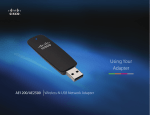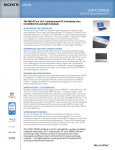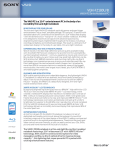Download Plus M-10 User guide
Transcript
quick reference guide / Product Overview Product Overview Wireless (Blue) The Wireless LED lights up when the wireless feature is enabled. It flashes when the Valet sends or receives data over the wireless network. Thank you for choosing a Cisco Valet wireless hotspot. This Quick Reference Guide covers both the Valet (M10) and Valet Plus (M20) models. Valet will be used as a general reference to both models and all details in this Quick Reference Guide apply to both models unless a specific model number is noted. Internet (Blue) The Internet LED lights up when there is a connection made through the Internet port. It flashes to indicate network activity over the Internet port. The Valet lets you and others in your home access the Internet wirelessly with a wireless equipped device such as a laptop or desktop computer, gaming device, or phone. The Valet wireless hotspot also has Fast Ethernet ports that allow you to connect up to four wired devices. The Valet Plus features Gigabit Ethernet ports for even faster wired speeds. You can also use your Valet wireless hotspot to share resources, such as computers. A variety of security features help to protect your data and your privacy while online. The Valet includes the Cisco Connect software that helps to manage your Valet settings, local and guest access, and parental control settings. (M20 Only) (Green/Blue) The LED lights up green when the port is connected to a gigabit port or blue when the port is connected to a 10/100 port. Power (Blue) The Power LED lights up when the Valet is powered on. When the Valet goes through its self-diagnostic mode during every boot-up, the LED flashes. When the diagnostic is complete, the LED is continuously lit. Back Top Internet 4 3 Ethernet 2 1 Reset 12VDC Power Back Top of Valet Plus 1, 2, 3, 4 (Blue) These numbered LEDs, corresponding with the numbered ports on the back of the Valet, serve two purposes. The LED is continuously lit when the Valet is connected to a device through that port. It flashes to indicate network activity over that port. (M20 Only) (Green/Blue) The LED lights up green when the port is connected to a gigabit port or blue when the port is connected to a 10/100 port. Internet The Internet port is where you connect the network (Ethernet) cable from your Internet connection. In most cases you will be connecting one end of the network cable to the Ethernet port on your cable or DSL modem and the other end to the Internet port on your Valet wireless hotspot. 4, 3, 2, 1 Using network cables, these Ethernet ports (4, 3, 2, 1) connect the Valet to computers or other devices on your wired network that have Ethernet ports such as gaming consoles, HDTVs, Blu-ray disc players, or printers. Reset Press and hold the Reset Button for approximately five seconds to reset the Valet to its factory default settings. Power The Power port is where you connect the power adapter. Wi-Fi Protected Setup Button If you have client devices, such as wireless adapters, that support Wi-Fi Protected Setup™, then you can use the Wi-Fi Protected Setup button to automatically configure wireless security for your wireless network(s). NOTE: You don’t need to use this option if you are using the Easy Setup Key to connect devices to your network.. 1 / Cisco Connect Cisco Connect Mac OS X During installation, the setup software installs the Cisco Connect software on your computer. Cisco Connect offers options to connect additional computers or devices to your Valet and allows you to modify the Valet’s settings. b. Double-click Connect. a. Double-click the USB drive on your desktop. 3. Read the Software End User License Agreement. To accept the agreement and continue with the installation, click Next. Installation To install the Valet: 1. Insert the Easy Setup Key into a USB port on your computer. License Agreement 4. Follow the on-screen instructions to complete the installation. Insert Easy Setup Key 2. Click Connect to your Cisco Valet. DVD/CD-RW Drive (E:) Linksys Router Setup Always do this for software and games: AutoPlay Connect your Cisco Install or run program Always do this for software and games: Install or run program Connect to your Cisco Valet Published by Cisco Consumer Products LLC General options Open folder to view files using Windows Explorer Speed up my system using Windows ReadyBoost Connect to your Cisco Valet Published by Cisco Consumer Products LLC General options Set AutoPlay defaults in Control Panel Open folder to view files using Windows Explorer Speed up my system using Windows ReadyBoost Set AutoPlay defaults in Control Panel Connect to your Cisco Valet If you do not see this, open the Easy Setup Key folder and double-click Connect. To do so, perform the following steps for your specific operating system: Windows 7 & Windows Vista Connection Overview NOTE: You can view detailed connection steps by clicking in the setup software. NOTE: If you have any trouble during the installation process, call us at 877-500-8070 (United States only) a. Go to Start > Computer. b. Double-click Easy Setup Key in the list of available drives. c. Double-click on Connect.exe. Windows XP a. Go to Start > My Computer and select Easy Setup Key. b. Double-click Connect.exe. 2 / Cisco Connect Main Menu Main Menu – Parental Controls The main menu offers four options: Parental controls restrict Internet access for up to five computers. For the computers you select, you can block or limit Internet access to specific times. You can also block specific websites. •• Computers and Devices •• Parental Controls •• Guest Access •• Valet settings To select an option, click on it. Parental controls restrictions are being applied to x device(s) Shows how many devices have parental controls restrictions enabled. Change Click to enable parental controls or change settings. Refer to Parental Controls, page 6. Main Menu – Guest Access The guest network provides Internet access only. To grant Internet access to friends or family, provide the guest network name and password displayed on this screen. Main Menu Local Access versus Guest Access You can connect computers or devices to your Valet by giving them local access (Computers and Devices option) or Guest Access (Guest Access option). Computers and Devices with local access will have access to the Internet and to other devices on your local network, including shared computers and printers which are connected to the Valet. Local access can be given to a wired or wireless device. Refer to Computers and Other Devices, page 4 for more information. Guest Access allows you to provide guests visiting your home with Internet access. Your guests will not have access to your other computers or personal data. Provide your guest with the Guest Network name and password. Guest computers must connect to your network using a wireless network connection. Refer to Main Menu – Guest Access, page 3 and Guest Access Settings, page 8 for more information. Main Menu – Computers and Devices Use this option to connect other computers or devices to your Valet’s local network, one at a time. There is x device(s) connected to your Valet Shows how many devices are connected to your Valet. NOTE: Guest Access provides Internet access only; it does not provide access to your local network and its resources or your personal information. For example, the guest computer cannot print to a printer on the local network or access files on a computer on the local network. Guest access helps minimize exposure of your local network and your family’s private information. Guests can connect to x-guest using the password xyz When a guest wants Internet access in your home, have the guest do the following: 1. Connect to the wireless guest network, which is the name of your wireless network followed by -guest. 2. Open a web browser. 3. On the login screen, enter the guest access password and click Login. Change Click to disable guest access or change settings. Refer to Guest Access Settings, page 8. Main Menu – Valet Settings Use this option to personalize the Valet’s settings. Valet name is x Shows the name of the Valet. Safe Web Surfing Shows the on/off status of the Safe Web Surfing option. Change Click to change the Valet settings. Refer to Valet Settings, page 9. Add device Click to connect another computer or device to the Valet. Refer to Computers and Other Devices, page 4. 3 / Cisco Connect Computers and Other Devices The computers or devices you connect with this option will have access to the Internet and your local network, including computers or other devices, such as a printer, connected to the Valet. If you have a guest visiting your home, you can provide Internet access only (no access to your local network) through the guest access feature. Refer to Guest Access Settings, page 8 for more information. Connecting Another Computer Connect with the Easy Setup Key 1. Insert the Easy Setup Key into an available USB port on the computer that you want to connect to the Valet. Connect Another Computer or Device Computer Click to connect another computer in your home. Refer to Computer, page 4. Wireless printer Click to connect a wireless printer. Refer to Wireless printer, page 5. Other devices Click to connect a device that is not a computer, such as a smartphone or gaming console. Refer to Device, page 6. Computer Your Cisco Valet came with an Easy Setup Key. The Easy Setup Key holds the settings for the Valet. There are three options available when you choose to add a computer. •• Yes, I have an Easy Setup Key If you already have an Easy Setup Key, select this option. Click Next. Refer to Connect with the Easy Setup Key, page 4. 2. On that computer, click Connect to your Cisco Valet. If you do not see this, open the Easy Setup Key folder and double-click Connect. 3. Follow the on-screen instructions to connect that computer to your Valet. 4. Return to the original computer running the Cisco Connect software and enter a name that will be used to identify the device. Click Finish. •• No, I don’t have an Easy Setup Key — create a new one now If you want to create or update an Easy Setup Key, select this option. Click Next. Refer to Update or create an Easy Setup Key, page 5. •• I want to connect manually using my wireless settings If you want to connect manually (without an Easy Setup Key), select this option. Click Next. Refer to Connect without the Easy Setup Key, page 5 Name Your Device 4 / Cisco Connect Update or create an Easy Setup Key 1. Insert the Easy Setup Key or your own USB flash drive into an available USB port on your computer. Wait while the files are copied to the Easy Setup Key. Name Your Device Wireless printer Update or Create an Easy Setup Key 2. Remove the Easy Setup Key and click Close. You can now use it to connect other computers to the Valet. Refer to Connect with the Easy Setup Key, page 4 to complete the process of adding another computer. 1. Refer to your printer’s documentation to learn how to connect it to a wireless network. 2. Enter the Network name (SSID), Security Key, and Security Type settings on your wireless device. To print this information, click Print these settings. Wireless Network Settings Easy Setup Key Has Been Updated Connect without the Easy Setup Key 1. Enter the Network name (SSID), Security Key, and Security Type settings on your wireless device. To print this information, click Print these settings. 3. Wait until your printer connects. On the Connecting a wireless printer screen, click Next. 4. Enter a name that will be used to easily identify your printer. Name Your Printer Wireless Network Settings 2. After connecting your device, click Next. 3. Enter a name that will be used to identify this device. Then click Finish. 5 / Cisco Connect Device First-Time Access of Parental Controls 1. Enter the Network name (SSID), Security Key, and Security Type settings on your wireless device. To print this information, click Print these settings. 1. The first time you access parental controls, you will be asked to create a parental controls password. Complete the following: –– Parental controls password Create a password of 4-32 characters that protects access to parental controls. –– Verify password Re-enter the password. –– Secret question Create a secret question and answer pair. If you forget the password, you can reset it by correctly answering the secret question. Enter your question (up to 64 characters maximum). –– Answer Enter the answer to your secret question (up to 32 characters maximum). Wireless Network Settings 2. After connecting your device, click Next. 3. Enter a name that will be used to identify the device and click Finish. Click OK to save your settings. 2. Select the computer that you want to set up parental controls for. Then click OK. Set Up Parental Controls For Name Your Device 3. The Parental controls main screen appears. Parental Controls For the computers you select, you can block or limit Internet access to specific times. You can also block specific websites. Manage Parental Controls You have the following options: Parental Controls Password Restrict Internet access on The list of computer(s) you have selected for parental controls is displayed. To add, remove, or rename computers on this list, refer to Restrict Internet Access List, page 7. To set up parental controls on a computer, refer to Set Up Parental Controls, page 7. Change parental controls password Click to change the password that protects access to parental controls. Refer to Change Parental Controls Password, page 8. 6 / Cisco Connect Restrict Internet Access List Set Up Parental Controls To set up parental controls for a computer, follow these instructions: 1. Select the computer from the Restrict Internet access on list. (If the computer is not listed, click Add to select the computer.) Parental Controls Add Click to apply parental control settings to additional computers. If you clicked Add, the Set up parental controls for screen appears. Parental Controls 2. The Block Internet access option offers the following: –– Always Select this option to block Internet access continuously on the selected computer. –– Specific times To block Internet access during specific days and times on the selected computer, select this option and set the schedule: •• School nights Select the appropriate start and end times. Set Up Parental Controls For •• Weekends Select the appropriate start and end times Select the computer whose parental controls you want to set up. Then click OK. –– Never Select this option if you do not want to Remove If there is a computer that you want to remove parental controls from, select the computer and click Remove. 3. The Block sites inappropriate for option allows you to block websites based on content. The following options are available: Rename To give a computer a new name, select the computer and click Rename. –– Don’t Block Select this option if you do not want If you clicked Rename, the Rename the device screen appears. –– Teen Blocks websites that contain content that restrict access during specific times. to restrict access to any websites. may be inappropriate for teenagers. –– Child Blocks websites that contain content that may be inappropriate for children. Rename the Device Enter the new name. Then click Rename. 7 / Cisco Connect 4. For the Block specific sites option, click Edit to create a list of websites you want to block. The default is None. turned off for the hour including any teen or child content settings or blocked sites. If you clicked Edit, the Block these sites screen appears. Blocked Site Block These Sites Guest Access Settings a. Enter a website address on each line. b. Click Save to save your settings. 5. On the Parental controls screen, click Finish to save your settings. NOTE: Repeat steps 1-4 to set up parental controls for different computers. Change Parental Controls Password If you clicked Change parental controls password, the Change your parental controls password screen appears. Guest Access Settings Allow guest access By default, Guest Access is enabled. To disable Guest Access, select no. Guest network name By default, the setup software sets up the name of the guest network. You can’t change the Guest Network Name as it is directly tied to the Valet Name. If you change the Valet Name, it will change the Guest Network Name. Refer to Change Valet Name or Password, page 9 Change Your Parental Controls Password •• Old password Enter the current password. Password By default, the setup software sets up the password for the guest network. To change the password, click Change. If you clicked Change, the Change guest password screen appears. •• New password Enter a new password that contains at least 4 characters but doesn’t exceed 32 characters. •• Verify password Re-enter the new password. Click Change to save your setting. Blocked Sites When you attempt to access a website that has been blocked on your computer, you will see a screen telling you that the site has been blocked and the reason it was blocked. You can override the blocking for an hour by entering the parental controls password in the Password field and clicking Unblock. All access restrictions will be Change Guest Password 8 / Cisco Connect •• Enter a new guest password Enter a password of Other Options •• Click Change to save your setting. Register now to receive special offers and updates To sign up to receive special offers and updates, click this option. 4-32 characters. Total guests allowed By default, 5 guests are allowed Internet access through your guest network. If you want to allow more or less, select the desired number of guests from the drop-down menu ; you can select up to 10 guests. NOTE: Computers that are connected to the local network do not count towards the number of guests allowed. Click Finish to save your settings. Valet Settings Valet details To view more information about the Valet, click Valet details. Refer to Valet Details, page 10. Advanced settings To access settings for advanced users, click Advanced settings. Refer to Advanced Settings, page 10. Click Finish to save your settings. Change Valet Name or Password NOTE: If you change the Valet name or password, then the wireless computers or other devices connected to the Valet will need to be reconnected using the new name or password (for more information, refer to Computers and Other Devices, page 4). If you clicked Change, the Changing Valet name or password screen appears. 1. To change the Valet name or password, click Yes. Otherwise, click No. Valet Settings Personalize Valet name The name of your Valet is displayed (this is also the name of your wireless network). To change the name, click Change. Refer to Change Valet Name or Password, page 9. Password The password that protects access to the Valet’s settings is displayed (this also protects wireless access to your local network). To change the password, click Change. Refer to Change Valet Name or Password, page 9. Easy Setup Key Update or create key The Easy Setup Key is a USB flash drive that holds the settings for the Valet. To create or update the Easy Setup Key, click Create or update key. For more information, refer to Update or create an Easy Setup Key, page 5. Changing Valet Name or Password 2. Complete the following: •• Valet name Enter a name of 1-32 characters. •• Password Enter a password of 8-63 characters. •• Click Change to save your settings. Safe Web Surfing On/off Safe web surfing alerts you when you are about to visit a potentially harmful website. You can choose whether to visit the site or not. Safe web surfing is enabled by default. Changing Valet Name and Password 9 / Cisco Connect Valet Details The Valet details screen displays model, software, and Internet connection details. These are useful when you are contacting our support team. Copy To copy the details to a text file, click Copy and follow these instructions: 1. Open a text editor, such as Microsoft Word or Notepad. 2. Go to Edit > Paste. Click OK to open the web browser and access the browser‑based utility. Click Cancel to return to the Valet settings screen. For information about Advanced Settings, refer to the User Guide on our website at www.ciscovalet.com/support. How to Exit Cisco Connect To exit Cisco Connect, click Close on the main menu. How to Access Cisco Connect 3. Go to File > Save. Windows To access Cisco Connect, go to Start > All Programs > Cisco Connect. Mac To access Cisco Connect, go to Go > Applications > Cisco Connect. Valet Details Click Close to return to the Valet settings screen. Advanced Settings If you are an advanced user, you can access the browser‑based utility to access the advanced configuration settings of the Valet. WARNING: Modifying some settings in the browser‑based utility may disable settings you’ve already applied using the Easy Setup Key. Username This is the username that is used to access the browser‑based utility. Password This is the password that is used to access the browser‑based utility. Copy password To copy the password to the Clipboard, click this option. Advanced Settings 10 / Support Support If your computer can’t connect to the Internet. If your computer can’t access the Internet, try the following: •• Check that the power cord on the Valet is connected to a power outlet. If connected to a power strip, make sure the power strip is turned on. •• Check to make sure that the power light, Internet lights, port lights and wireless lights are on. •• Check that the Valet is connected to your DSL or cable modem using a network cable. •• Turn off your DSL or cable modem and your Valet, and wait 30 seconds. Turn the modem on, wait 30 seconds, and then turn on your Valet. Reboot your computer and try to connect to the Internet again. •• If your PC does not have a wireless network adapter, we recommend the Valet Connector (Cisco AM10) Contacting Support Our award-winning support resources are available 24/7/365. As a Valet owner you can rest easy, knowing that qualified technical support specialists are just a phone call away. 877-500-8070 (United States only) If you have Internet access you can get instant help from our online tools. There you’ll find step-by-step solutions to common questions. Or, visit our online community forum and chat with other Valet owners. Simply visit our support website at www.ciscovalet.com/support. It’s a great way to get the answers you need without waiting on hold! © 2010 Cisco Systems, Inc. All rights reserved. Cisco, the Cisco logo, and Valet are trademarks or registered trademarks of Cisco Systems, Inc. and/ or its affiliates in the United States and certain other countries. All other trademarks mentioned in this document or website are the property of their respective owners. The use of the word partner does not imply a partnership relationship between Cisco and any other company. 10020910NC-RR 11





















